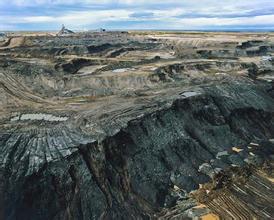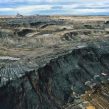
The End of China’s Play in the Canadian Oil Sandbox?
Publication: China Brief Volume: 15 Issue: 19
By:

Only three years ago, China National Offshore Oil Corporation (CNOOC), China’s third-largest national oil company (NOC), launched the largest-ever Chinese overseas takeover bid, offering $15.1 billion to buy Nexen Inc., Canada’s ninth-largest oil company. Together with China National Petroleum Corporation and Sinopec Group, China’s two largest NOCs, and other state-owned financial institutions, Chinese firms invested around $35 billion in Canada’s energy sector between 2009 and 2013, making Canada the destination of one-third of Chinese overseas energy investment in this period (China Economic Weekly, May 13). But the “Great Leap Forward” of Chinese investment in Canada has proven controversial, as evidenced by the intense debate over CNOOC’s acquisition of Nexen in the fall of 2012, and the recent criticism of the company’s oil leaks in Alberta (BNN, September 2).
With the rapid decline of oil prices in the past year and the heavily discounted energy stocks, Chinese equity holdings in the Canadian energy sector have also come under scrutiny in both countries, especially regarding the value and sustainability of some of the large projects. While Canadians continue to argue about the merits of Chinese capital inflow, Chinese companies are reflecting on the costs of investing in a stable market.
The Dragon’s Return to Canada’s Oil Sandbox
The significant injection of Chinese funds into Canada’s energy sector occurred during a short-lived honeymoon between the two countries. When Canadian Prime Minister Stephen Harper’s Conservatives took office in 2006, they were not friendly to China due to their lack of foreign policy experience and political positions. Beijing responded by slowing its investment momentum in Canada’s energy sector, which had begun with a number of projects in 2005, leading to a prolonged low point in bilateral relations. [1]
The 2008 worldwide economic crisis put Canada, a country heavily dependent on foreign investment in its energy and resource sectors, in a difficult financial position. Additionally, U.S. President Barack Obama’s initial decision to delay the approval of the Keystone XL pipeline from Canada’s Edmonton to the U.S. Gulf Coast the following year angered Harper, who campaigned for the pipeline and expected a speedy agreement with the United States.
Turning to China for leverage, Harper made his first visit to Beijing in late 2009, and appealed to the Chinese leadership and top NOC executives for continued investment in Canada. At the same time he promised to speed up the conclusion of a bilateral investment protection treaty which had been on the negotiation table for many years. The Chinese premier at the time, Wen Jiabao, chided Harper for the delayed visit, but enthusiastically responded to Harper’s call for closer cooperation in the area of energy and resource development (China News Network, December 3, 2009).
Beijing had good reason to embrace Canada with open arms: China was in a period of rapid economic expansion; the increasing need for energy and resources that began in the early 2000s—the “commodities super-cycle” driven by Chinese demand—pushed up global prices for energy and key minerals. High prices forced Beijing to spend much of its hard-earned foreign currency on importing these resources, with oil imports being the largest annual foreign reserve expense. Canada became a prime destination for energy investment. A stable and advanced industrial country, Canada has the third-largest global oil reserves—only Saudi Arabia and Venezuela have more. Moreover, most of the world’s oil reserves are controlled by national oil companies. In contrast, Canada’s oil is not state monopolized (there are no national oil companies in Canada), and the accounts for over 70 percent of the world’s oil and gas resources that are open to foreign investment. For China, a country anxious to secure its oil supply in the coming years and decades, Canada seemed like an ideal partner.
President Hu Jintao immediately paid a return visit to Canada in the summer of 2010, leading a delegation of senior government officials and business leaders. In the following years, all the “Big Three” Chinese national oil companies as well as China Investment Corporation (CIC), Bank of China and other large financial institutions poured money into Canada’s energy sector in the form of equity investment, joint ventures, mergers and acquisitions. The following table shows a summary of the largest energy deals between China and Canada in this period.
Major Chinese Investment in Canada’s Energy Sector 2009-13
INVESTMENT CANADIAN FROM
DOLLARS
Teck Resources $1.5 bil. China Investment Corp.
Athabasca Oil Sands Corp. $1.9 bil.+ $1.9 bil. PetroChina/CNPC
Syncrude $4.6 bil Sinopec
Penn West Energy $1.2 bil China Investment Corp.
Encana $5.4 bil PetroChina/CNPC (failed)
Opti/Nexen $2.1 bil. CNOOC International
Daylight (100%) $2.2 bil. Sinopec Group
Shell Canada $1.1 bil. PetroChina/CNPC
Talisman (North Sea) $1.5 bil. Sinopec Group
Nexen (100%) $15 bil. CNOOC International
EnCana $2.2 bil. PetroChina/CNPC
In addition to repaired relations between the Harper government and the Chinese leaders, and the potential of large returns, Beijing’s investment in Canada’s energy sector was also due to the vulnerable nature of its investment in natural resource sectors in Africa, the Middle East and other third world countries in the past two decades. In this sense, investments in Canada represented a hedge against losses in less reliable markets—which proved wise. The Sudanese civil war and subsequent split into two countries (where Chinese NOCs are heavily involved), the Libyan crisis and civil war and the volatile situation in other African and Middle Eastern countries have cost Chinese investors dearly.
For the Chinese state-owned enterprises (SOEs) and national oil companies, more than a decade of the “go-out” strategy, much of which was targeted at investing in resource assets in the third world countries, has led to mixed results. They came to realize that political stability and the rule of law are as important, if not more so, as the fast and high profit margins some of the developing countries offer. Canada (often grouped with Australia) is seen as a safe bet in this regard, even though the cost of doing business is high, and the regulatory procedures on project approval and environment assessment are complex and slow.
This stability partially explains why the top three Chinese NOCs, although having only limited exposure to Canada’s energy market, all decided to make bold investments in Canada between 2009 and 2013, as the above table demonstrates. While all Chinese investors cultivated good relations with Canadian federal and provincial government (the three Western provinces of Alberta, British Columbia and Saskatchewan in particular), and trusted Canada and U.S.-based investment bankers, law firms and due diligence agencies, different NOCs and financial houses practiced different investment strategies. The following patterns can be identified in the $35 billion invested thus far.
First, Chinese financial institutions mostly preferred equity investment. In such a format, large sums were injected into selected Canadian firms while trusting the Canadian company executives to manage the investment and get a good return. For example, China’s leading sovereign wealth fund, the China Investment Corporation (CIC), invested in two firms: Tech Resources in 2009, then in Penn West Energy the following year. Later, CIC, together with a few other Chinese institutional investors bought large numbers of shares of Sunshine Oilsands Ltd. when that company had its initial public offering on the Hong Kong Stock Exchange in 2012.
Second, PetroChina (China National Petroleum Corporation’s international arm) pursued large-scale joint venture projects in oil sands extraction and gas production. Although PetroChina entered Canada with a small oil field operation as early as the mid-1990s, the Chinese energy giant’s investments were relatively low key until it entered into a $5 billion joint venture with a relatively new Canadian oil sands company, Athabasca Oil Sands Corp (AOSC), in 2010 (Canada Newswire, February 10, 2010). PetroChina set up its Canadian subsidiary (Phoenix Energy, and later Brion Energy) to partner with AOSC in two separate Joint Venture (JV) projects: MacKay River and Dover, with PetroChina taking a 60 percent stake in each.
Third, Sinopec Group has deliberately chosen to invest in localized operations, depending on Canadian consortiums and Canadian managers. After its initial investment in Canada’s oil sands sector in 2005, Sinopec upped its investment, paying $4.65 billion for ConocoPhilips’s entire stake in the Syncrude Group, the largest Canadian oil sands producing consortium, in 2010. Sinopec went on to acquire 100 percent of Daylight Energy for $2.2 billion. For its operations, Sinopec Canada depends heavily on local Canadian managers. Currently, the CEO, COO and CFO of Sinopec Canada are all Canadians. Despite having well over $10 billion total investment in Canada’s energy sector, Sinopec Canada has only received around 15 working visas from the Canadian government. [2]
Reality Check on Chinese Investment in Canada
The speed of deployment of Chinese capital into Canada’s energy heartland was somehow unexpected by the Canadian government and the general public. The concerns of Chinese control of vital Canadian resources were so strong that Prime Minister Harper put out specific measures to limit foreign SOE investment at the same press conference where he was announcing the approval of the CNOOC’s takeover of Nexen in late 2012. Beijing considered such steps to be targeting China, and bilateral relations have since cooled.
Ironically, Chinese energy operations in Canada, like all Canadian and foreign companies, have been affected by a myriad of troubles in recent years: rising costs, delayed project completions, cumbersome regulatory processes, infrastructure bottlenecks and in the past year, rapidly declining oil prices and related uncertainties for the entire energy industry. Contrary to Sinopec’s original expectations, the Northern Light oil sands project will probably never be developed given the current market conditions. A major investigative report claimed that most Chinese investment in Canada’s energy sector has been heavily discounted due to various reasons, as the majority of CIC’s Canadian assets have lost more than 80 percent of their original value (Financial Post, May 29). These factors are likely behind the reduced inflow of Chinese capital over the past 20 months.
And yet, there are additional challenges facing Chinese investors, who are relatively new to Canadian market realities. After all, they must come to terms with a profoundly different linguistic, cultural and operational business environment, not to mention with regulatory restrictions that are imposed specifically on state-owned enterprises. Chinese investors are working hard to follow the rules of the game set by the Canadian government and to establish their bona-fides as committed local corporate citizens, so they undoubtedly intend to stay for the long haul.
Conclusion
The Canadian debates on the nature of Chinese investment in Canada, as shown during the CNOOC-Nexen debate in 2012, have also gone through an interesting twist. While critics continue to doubt the net benefit of Chinese capital inflow to Canada, few people today articulate the kind of scary scenario, as they did a few years ago, that Chinese investors, backed by the Chinese government, are coming to take over Canada’s resource sectors. In the United States, domestic oil and gas production has increased, removing energy security as a key domestic and foreign policy priority in U.S. politics. This has also led to a more relaxed attitude regarding the Chinese presence in Canada’s energy sector. Ultimately, it will be the Chinese investors who have to continue to sustain their operations in Canada, and hope for better payoffs in Canada’s vast oil sandbox.
Wenran Jiang is the Director of Canada-China Energy & Environment Forum. He has directed its annual conference since 2004, and is a Global Fellow at the Woodrow Wilson International Centre for Scholars.
Notes
1. For earlier accounts of Chinese investment in Canada, see the author’s two previous publications: Fueling the Dragon: China’s Quest for Energy Security & Canada’s Opportunities (2005), and The Dragon Returns: Canada in China’s Quest for Energy Security (2010).
2. Author’s discussion with Sinopec senior executives in Beijing, Oct. 29, 2014.





